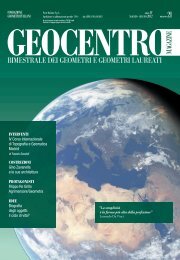Geocentro Magazine - numero 6 - novembre/dicembre 2009
Geocentro Magazine - numero 6 - novembre/dicembre 2009
Geocentro Magazine - numero 6 - novembre/dicembre 2009
Create successful ePaper yourself
Turn your PDF publications into a flip-book with our unique Google optimized e-Paper software.
66<br />
ANNO I | n. 6 | NOVEMBRE - DICEMBRE <strong>2009</strong><br />
territorio dei tanti agrimensori e periti del suo tempo, anche<br />
se il suo avvicinamento alla rappresentazione cartografica<br />
non deriva certo da intenti di tipo professionale.<br />
Leonardo non è un cartografo in senso stretto, ma si occupa<br />
di cartografia per specifiche necessità di studio e per esigenze<br />
di analisi, finalizzate alla progettazione territoriale o alla<br />
pianificazione di attività belliche.<br />
Per entrare più direttamente nel merito delle sue opere<br />
cartografiche bisogna preliminarmente spostare l’attenzione<br />
dal mondo delle mappe a quello della rappresentazione in<br />
generale, cioè del disegno e della pittura, che per Leonardo non<br />
sono semplicemente un linguaggio per ripetere visivamente<br />
cose già note, ma, come ha osservato Giulio Carlo Argan,<br />
“sono la chiave con cui si penetra nel mondo dei fenomeni”.<br />
È infatti dai precetti derivanti dal Libro di pittura che si<br />
recuperano i fondamenti innovativi della sua produzione<br />
cartografica.<br />
La formula adotta da Leonardo nel rilevamento e nella<br />
rappresentazione cartografica è sintetizzata nel precetto che<br />
egli stesso ferma nei suoi appunti del Manoscritto L dell’Istituto<br />
di Francia, dove egli annota: “scorta sulle sommità e in su’ lati<br />
dei colli le figure di terreni e le sue divisioni e nelle cose volte<br />
a te, fale in propria forma” (Ms. L dell’Istituto di Francia, f. 21<br />
are solved through the use of the fi rst principle of similitude<br />
between right-angled triangles and through the so called “rule<br />
of three”. However, the most relevant contribution of this work<br />
consist in a new method of topographical surveying that is<br />
meant to solve the question of the mutual position on the urban<br />
scale through a triangulation work. Such a work had already<br />
been anticipated by Giovanni Fontana in his Tractatus de<br />
trigono balistario abbreviatus […] in 1440. Th is essay was<br />
recovered and completed by diff erent Renaissance scholars, and<br />
was furthermore ameliorated for other fi ve centuries, until<br />
nowadays.<br />
For this triangulation, they used a goniometer divided in 48<br />
parts, still without an alidade and a compass pointing to the<br />
magnetic North, and still with the help of a plumb line.<br />
Alberti fully describes his method, explaining how to<br />
manufacture the adequate instrument and, step by step,<br />
how operate in order to obtain a correct survey. Moreover, he<br />
explains all the rules to follow in the observation of the angular<br />
directions among the diff erent sites and in their registrations.<br />
Nevertheless, there are no instructions about the representation<br />
of the dimensions and the orientation of the various polygons<br />
surveyed.<br />
Th e second essay, Descriptio urbis Romae, is a much more<br />
original step forward. It shows how an urban plan could be<br />
sketched on a map, according to polar coordinates collected<br />
and organised within standard tables.<br />
Th e instrument that enables the technicians to draw such<br />
tables is a protractor, called Orizon. It is provided with a<br />
graduated radius that is hinged in the middle of the instrument<br />
itself, exactly as it happens in the modern, graduated circular<br />
protractor having a pivoted arm, used for measuring or<br />
marking off angles.<br />
When it has represented on a sheet of paper the plan of a town<br />
measured through the triangulation method explained in the<br />
Ludi, a surveyor establish in this representation the basis of a<br />
cartographic system of reference: starting from a central point,<br />
he can measure with the Orizon the polar coordinates of every<br />
single place on the graphic. We are talking about distances and<br />
angles from a starting point that can give way to the setting<br />
down of a table with the name and the position of every<br />
represented topographical detail, a sort of encrypted map. Such<br />
a table, obtained through a graphical representation and not<br />
by a practical survey on the fi eld, represents a revolutionary<br />
step forward: the cartographer willing to obtain another map,<br />
identical to the original one, could certainly be able to make a<br />
copy perfectly matching the fi rst sample.<br />
Considered from this point of view, the whole method suggested<br />
by the Descriptio could appear like a mere academic exercise:<br />
the advantages of taking polar coordinates as a reference are<br />
obvious at fi rst sight, as such a process allows the creation of<br />
a faithful reproduction from an original map. However, this<br />
method is by far more productive than a simple technique<br />
for a geometrical copy of a topographical map (a copy that<br />
http://it.wikipedia.org/wiki/File:Leonardo_self.jpg






